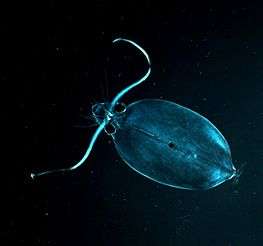Cranchiidae
The family Cranchiidae comprises the approximately 60 species of glass squid, also known as cockatoo squid, cranchiid, cranch squid, or bathyscaphoid squid.[2] Cranchiid squid occur in surface and midwater depths of open oceans around the world. They range in mantle length from 10 cm (3.9 in) to over 3 m (9.8 ft), in the case of the colossal squid. The common name, glass squid, derives from the transparent nature of most species. Cranchiid squid spend much of their lives in partially sunlit shallow waters, where their transparency provides camouflage. They are characterised by a swollen body and short arms, which bear two rows of suckers or hooks. The third arm pair is often enlarged. Many species are bioluminescent organisms and possess light organs on the undersides of their eyes, used to cancel their shadows. Eye morphology varies widely, ranging from large and circular to telescopic and stalked. A large, fluid-filled chamber containing ammonia solution is used to aid buoyancy. This buoyancy system is unique to the family and is the source of their common name "bathyscaphoid squid", after their resemblance to a bathyscaphe. Often the only organ that is visible through the transparent tissues is a cigar-shaped digestive gland, which is the cephalopod equivalent of a mammalian liver. This is usually held in a vertical position to reduce its silhouette and a light organ is sometimes present on the lower tip to further minimise its appearance in the water.[3][4]
| Cranchiidae | |
|---|---|
 | |
| Cranchiid squid juvenile found in Antarctica | |
| Scientific classification | |
| Kingdom: | Animalia |
| Phylum: | Mollusca |
| Class: | Cephalopoda |
| Order: | Oegopsida |
| Family: | Cranchiidae Prosch, 1847[1] |
| Subfamilies | |
| |
| Synonyms | |
Like most squid, the juveniles of cranchiid squid live in surface waters, descending to deeper waters as they mature. Some species live over 2 km below sea level. The body shape of many species changes drastically between growth stages, and many young examples could be confused for different species altogether.
Cranchiid squid represent no interest to commercial fisheries.
The family is named for John Cranch.[5][6]


Genera
The family contains two subfamilies (both established by Georg Johann Pfeffer) and about 15 genera:[7]
- Subfamily Cranchiinae
- Genus Cranchia
- Genus Leachia
- Genus Liocranchia
- Subfamily Taoniinae
- Genus Bathothauma
- Genus Belonella
- Genus Egea
- Genus Galiteuthis
- Genus Helicocranchia
- Genus Liguriella
- Genus Megalocranchia
- Genus Mesonychoteuthis
- Genus Sandalops
- Genus Taonius
- Genus Teuthowenia
The genus listed above with an asterisk (*) is questionable and needs further study to determine if it is a valid genus or a synonym.
References
- Julian Finn (2016). "Cranchiidae Prosch, 1847". World Register of Marine Species. Flanders Marine Institute. Retrieved 26 February 2018.
- Mark Norman & C.C. Lu (2000). "Preliminary checklist of the cephalopods of the South China Sea" (PDF). The Raffles Bulletin of Zoology (Supplement No. 8): 539–567.
- Mark Norman 2000. Cephalopods: A World Guide. Hackenheim, ConchBooks, p. 156.
- Richard E. Young and Katharina M. Mangold (1922-2003). "Cranchiid Buoyancy". The Tree of Life Web Project. Retrieved March 14, 2012.
- David M. Damkaer (2002). "Adding pages". The Copepodologist's Cabinet: A Biographical and Bibliographical History, Volume 1. Memoirs of the American Philosophical Society, Volume 240. American Philosophical Society. pp. 131–155. ISBN 978-0-87169-240-5.
- White, Adam (1857). A Popular History of British Crustacea; Comprising a Familiar Account of Their Classification and Habits. Lovell Reeve. pp. 249–250.
- Richard E. Young and Katharina M. Mangold (1922-2003) (2008). "Cranchiidae Prosch, 1847. Bathyscaphoid squids". The Tree of Life Web Project. Retrieved March 14, 2012.